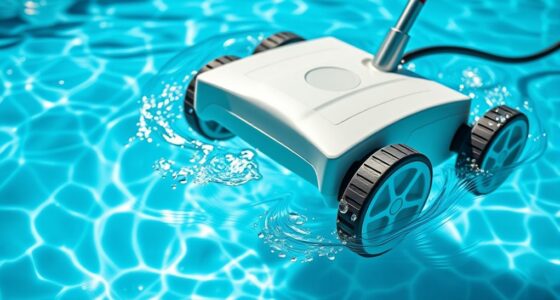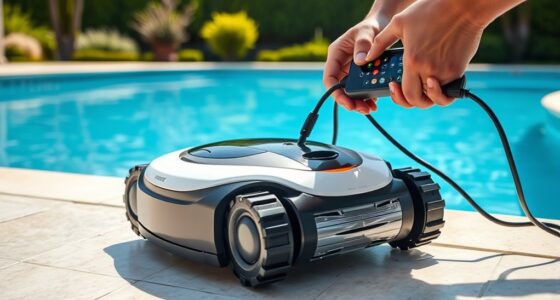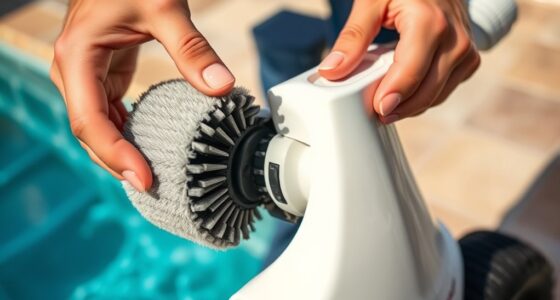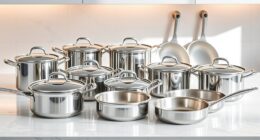To store your automatic pool cleaner during the off-season, rinse it thoroughly to remove dirt and chemicals, then dry all parts completely. Disconnect the power supply, remove batteries, and store everything in a cool, dry place away from sunlight. Properly coil cables and use protective covers to prevent damage. Regularly check for pests or moisture while stored. Keep these tips in mind to extend your cleaner’s lifespan and ensure it’s ready for next season. More helpful details await.
Key Takeaways
- Rinse the cleaner thoroughly with fresh water to remove residual chemicals, dirt, and debris before storage.
- Disconnect and store batteries separately in a cool, dry place to prevent corrosion and maintain battery health.
- Clean and inspect brushes, wheels, and filters; replace worn parts to ensure optimal performance for next use.
- Store the cleaner in a cool, dry, shaded area away from direct sunlight and environmental factors.
- Keep cables organized, and protect the device with covers or wrapping to prevent damage during long-term storage.
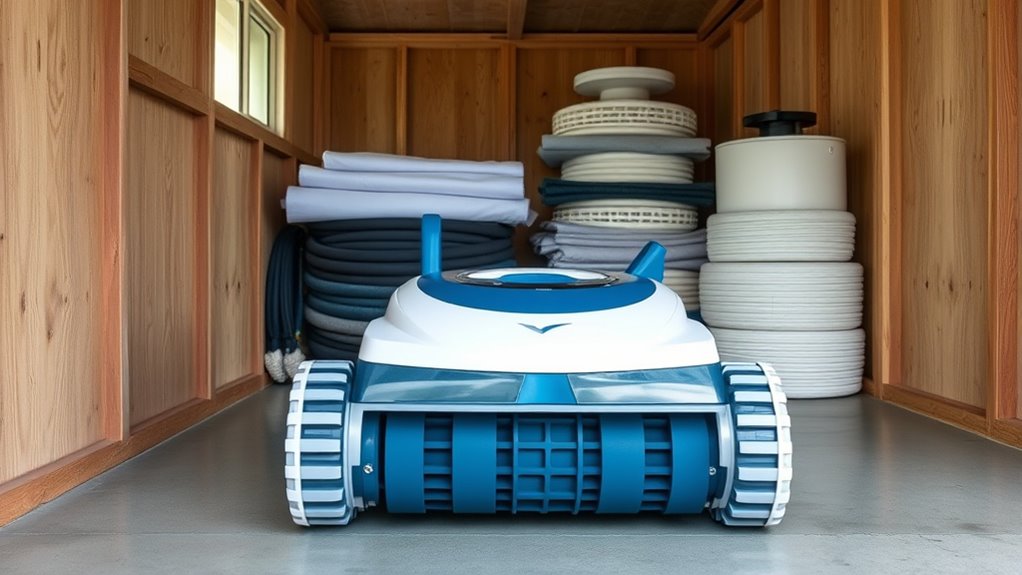
As the swimming season winds down, properly storing your automatic pool cleaner is vital to guarantee it stays in top condition for next year. Giving it the right care during off-season months prevents damage and ensures optimal performance when you’re ready to dive in again. To start, you should follow some essential maintenance tips that keep your cleaner in prime shape. First, thoroughly rinse the device with fresh water to remove any residual chemicals, dirt, or debris. This step stops the buildup of grime that can corrode components or cause mold growth during storage. Next, check the brushes, wheels, and filters, replacing or cleaning them as needed. Dirty or worn parts can impair performance, so it’s best to address these issues now rather than deal with them during the next pool season.
Once you’ve completed maintenance, focus on choosing the right storage solutions. Proper storage prevents damage from environmental factors such as sunlight, moisture, or pests. Find a cool, dry, and shaded spot where temperature fluctuations won’t cause cracking or warping. Avoid storing the cleaner in direct sunlight, which can degrade plastic parts over time. If possible, keep it inside a garage, shed, or storage closet. Before placing it in storage, ensure all parts are completely dry to prevent mold or rust. Some pool cleaners come with custom storage bags or containers—use these, as they’re designed to protect the equipment from dust and impact. If you don’t have a dedicated storage case, wrapping the cleaner in a clean, soft cloth can help shield it from scratches. Additionally, storing your cleaner according to manufacturer guidelines may extend its lifespan and maintain peak performance. Consulting the manufacturer’s instructions can provide tailored advice for your specific model, ensuring the best care.
Another important maintenance tip involves disconnecting the power supply and removing batteries if applicable. Store batteries separately in a cool, dry place to prolong their lifespan and prevent corrosion. For robotic cleaners with charging stations, unplug and clean the station thoroughly, wiping down any contacts to avoid corrosion. Make sure all cables are neatly coiled and stored away from sharp objects or heavy weights that might crush or damage them. It’s also beneficial to consult the user manual for specific storage instructions recommended by the manufacturer, ensuring optimal preservation. Properly inspecting and performing routine checks of your equipment during storage can help identify potential issues early and prevent costly repairs later.
Finally, double-check that the cleaner is stored in a manner that prevents accidental damage. Elevate it off the ground if possible, to avoid exposure to standing water or pests. Regularly inspecting your storage area during the off-season can help catch potential issues early, like pests or moisture buildup. Proper off-season storage may also benefit from preventive maintenance, which helps in avoiding costly repairs later. With these maintenance tips and proper storage solutions, your automatic pool cleaner will be preserved in excellent condition, ready to perform flawlessly when the swimming season begins again. Proper off-season storage isn’t just about protecting your investment—it’s about ensuring your pool stays clean and your equipment lasts for years to come.
Frequently Asked Questions
How Often Should I Clean My Automatic Pool Cleaner During Storage?
You should clean your automatic pool cleaner regularly during storage to guarantee it stays in good condition. Proper cleaner maintenance involves rinsing off debris and inspecting parts for damage. Follow storage tips like drying the cleaner thoroughly and storing it in a cool, dry place. This prevents mold, corrosion, and clogs, making sure your cleaner is ready to go when swimming season returns. Regular cleaning during storage helps prolong its lifespan.
Can I Store My Pool Cleaner Outdoors During Winter?
Ever wonder if outdoor storage is safe for your pool cleaner during winter? While it’s possible, it’s not ideal without proper winter protection. Exposure to snow, ice, and fluctuating temperatures can damage the motor and components. If you must store it outside, make certain it’s in a sheltered, dry spot, and use a waterproof cover. However, for best results, indoor storage offers the best winter protection and longevity.
What Type of Cover Is Best for Off-Season Storage?
For off-season storage, you should choose a cover made from durable, weather-resistant material like heavy-duty vinyl or polyethylene. These materials protect your pool cleaner from moisture, dust, and UV damage. Consider your storage location—if outdoors, opt for a waterproof cover with reinforced seams. Confirm the cover fits snugly to prevent debris from getting inside, keeping your cleaner in good condition until you’re ready to use it again.
Should I Drain the Cleaner Before Storing It?
Think of your cleaner like a well-loved book—proper maintenance guarantees it lasts. You should drain your automatic pool cleaner before storing it, as this prevents water from causing mold or damage. For ideal storage tips, clean and dry all parts thoroughly. This simple step keeps your cleaner in top shape, ready for the next season. Proper storage and cleaner maintenance protect your investment and extend its lifespan.
How Do I Prevent Mold and Mildew During Storage?
To prevent mold and mildew, you should focus on moisture control and maintaining a cleaning schedule. After using your cleaner, make sure to dry it thoroughly to eliminate excess moisture. Store it in a cool, dry place with good ventilation. Regularly inspect and clean the cleaner during storage to prevent mold buildup. Proper moisture control and consistent cleaning help keep your automatic pool cleaner fresh and ready for use.
Conclusion
Storing your automatic pool cleaner properly in the off-season is like giving it a peaceful winter nap, ensuring it’s ready to spring into action when summer returns. By cleaning, drying, and storing it in a safe spot, you protect your investment and prolong its lifespan. Just as a well-tended garden blooms again, a well-maintained cleaner will perform at its best next season. Keep it stored right, and you’ll enjoy sparkling clean pools year after year.


